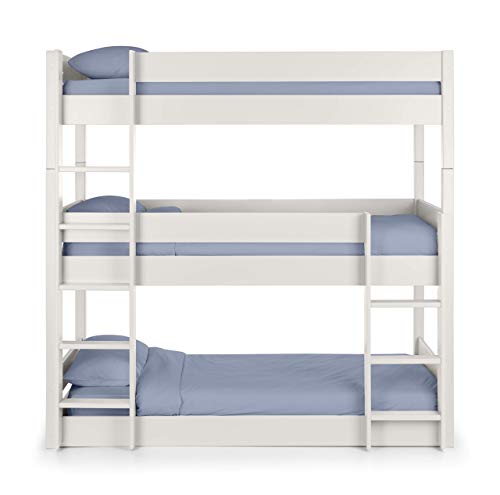Safety Considerations When Buying Kids Beds Bunk
Kids love bunk beds–they’re a great way to save space and add an exciting aspect to their rooms. If a bunk bed doesn’t have been well designed, it can be a danger to safety.
Be sure to prohibit horseplay and don’t hang items from the top bunks like scarves or jump ropes. Also, ensure that any ladders are secure. Learn more about these guidelines for designing a kids bed bunk that lasts.
Safety
Safety should be a top priority when it concerns bunk beds for children. A bunk bed that meets the standards for safety in the United States will help minimise the risk of injury. In addition, monitoring children during their sleep and enforcing safety guidelines can reduce the chance of accidents happening. In addition, ensuring that children’s bunk beds are correctly assembled and maintained will further reduce the chance of accidents.
The most common cause for injuries in bunk beds for children is falling off of the upper bed. It is crucial to install guardrails along the sides of the bed on top to avoid this. These rails must rise at least 5 inches above the mattress’s surface to prevent accidental falls.
It is essential to make sure that the railings are not gapped or loose, and that the space between them is narrow enough to keep the head or limbs of a child from getting trapped. It is also a good idea to design the mattress to fit snugly within the frame of the bunk beds to prevent gaps that could cause a hazard.
It is also recommended that parents supervise children who sleep on the top bunk, and show them how to climb the ladder. It is also a good idea to eliminate any obstructions or tripping hazards in the vicinity of the top bunk as well as the ladder access point.
In general, it’s best to allow only one child to sleep on the top bunk. Children who are less than six years old old are not yet able enough to walk up the ladder in a safe way. It is recommended to check your bunk bed frequently to look for loose parts or damage that needs to be tightened. Also, be sure to adhere to the weight restrictions established by the manufacturer on the top and lower bunks. It is also important to avoid adding unnecessary accessories to the bed since they can weaken its structure and increase the risk of a crash.
Design
Bunk beds aren’t only a great way to save space in a child’s room however, they can also be used to create a second bedroom, a study space or even an area for play. Children love sharing their bedrooms with siblings So why not make it more exciting with the bunk bed? A standard bunk allows one child to sleep on top, and another to sleep below. You can also consider a loft style of bunk bed that has an integrated staircase or banister. This enhances accessibility and also ensures that toddlers are able to easily reach the top bed. This is a great solution for bedrooms with small spaces. It can also be easily converted into two single beds when your children get older.
Many bunk beds have built-in shelves and drawers that can be used to store books, toys and clothes. These additional storage options make it easier for children to keep their rooms clean. These shelves can be used to store bedding and other items to ensure that your children always have clean sheets to use for sleepovers. If you don’t have enough space to accommodate these additional storage options, an assortment of freestanding shelves or bins can be set up near the bunks for a simple but efficient solution.
A neutral-colored bed is an excellent choice for any child’s room. It can also be easily modified as the child grows older. It’s easy to pair with a range of bedroom furniture and is a great option for a modern or contemporary home. It’s a classic style that will never fade out of fashion. This bed is an ideal choice for children who will be using it for many years.
Consider a wood finish with an elegant design if you want a bunk bed to look beautiful in your child’s bedroom. This bed is a great option for those with low ceilings or smaller bedrooms. It’s a classic design that will be a perfect fit with any decor. You can find a wide choice of wood bunk bed sizes, heights, entrance styles (ladder or stairs) as well as finishes and color options on our page of collections.
Stability
Stability is a major consideration when it comes to buying bunk beds for kids. The design and materials of the bunk bed will play a major role in this. Cheaper wooden frames tend to wobble, and become dangerous, compared to metal frames. The stability of the bed is improved by making sure that the ladder is attached to the bunk and is at an appropriate height for children to climb.
Another aspect to consider is the presence of guardrails on both sides of the top bunk in order to minimize the risk of falling. They should be placed at minimum 5 inches above the surface of the mattress and regularly checked for damage or poor installation. A quality mattress should also be selected to fit snugly within the frame, preventing gaps that can cause entrapment hazards. Additionally, it’s recommended to take into consideration the capacity of the mattress to anticipate potential growth and changes in body weight over time.
Examine for missing or loose screws on your metal bunk bed on a regular basis. kids bunk bed ‘s especially important if your children are using the bunk beds as they are able to easily take down the beds or move them if they get bored.
It’s also a good idea to install furniture anchors on the wall. They can be affixed to the bunk beds and furniture to stop them from falling over. They are simple to put in and are a great option to add extra peace of mind regarding your child’s security.
It is recommended that you wait until your children reach at least six years old before letting them sleep on the top bunk, because this is when they’re most likely to be able to handle the climb up and down without assistance. If you have kids who are young it is advisable to consider a corner loft bed or bunk bed that can be divided into individual beds to ensure that your children do not be fighting over the top bunk.
Stores
A bunk bed or loft bed is a unified unit made up of at least two beds placed on top of one another. This furniture is a great solution for kids to make the most of their floor space. It also offers plenty of storage space, from under-bed shelves to stairs that are also shelves. They’re available in a wide range of styles, finishes and configurations to suit the decor of any room for kids. You can even find a piece that can be divided into individual twin and full-size beds to provide flexibility as your child grows.
The best bunk bed for kids with storage can transform a bedroom into an exciting castle tower, or comfortable place to play games and take napping. It can also transform the bedroom into a place where kids can organize themselves and learn to keep their rooms clean and tidy. These models are not like storage beds which only provide an open space at the bottom. They often include built-in shelves or drawers to keep them organized and clutter-free.
Some models come with a staircase that can be used as an alternative to get to the bed. This can be a good option for kids who may not yet have the strength to climb the ladder on their own. Others feature both a front and an end ladder for added convenience, so you can choose which one is more appropriate depending on the layout of your child’s room.
Consider an loft bed if you are unsure whether your children are ready to sleep in a bunk. These elevated beds can make the most of floor space and they can be outfitted with desks or shelves to offer a complete storage and study solution. This Maxtrix Star loft bed is a good example. It includes an office desk that can be used as an office, or as a play area for creative kids, with shelves on each side for storing books or toys as well as other things.
In addition to safety concerns other important aspects to consider when choosing bunk beds or lofts for kids include the materials and design. Avoid cheap or flimsy bunks that can crumble easily, and opt for sturdy metal and wood frames. Make sure the bunk has been tested by an independent third party to ensure that it meets or exceeds the international and national standards for structural integrity, stability, and lead content.
Comments are closed
Categories
- aerocity call girls
- Architecture
- Art
- Arts & Entertainment, Celebrities
- Arts & Entertainment, Music
- Arts & Entertainment, Photography
- arts and entertainment
- auto loans
- budgeting
- business
- Business, Advertising
- Business, Article Marketing
- Business, Careers
- Business, Customer Service
- Business, Entrepreneurs
- Business, Home Based Business
- Business, Marketing
- Business, Sales
- Business, Small Business
- buying
- casino gambling
- Communications, GPS
- Communications, Mobile Phones
- Communications, Video Conferencing
- Computers, Computer Certification
- Computers, Data Recovery
- Computers, Games
- Computers, Hardware
- Computers, Software
- connaught place call girls
- dating
- debt consolidation
- debt management
- delhi call girls
- delhi escort
- Disease & Illness, Breast Cancer
- Disease & Illness, Colon Cancer
- electronics
- Fashion
- Fashion, Clothing
- Fashion, Jewelry
- finance
- Finance, Credit
- Finance, Currency Trading
- Finance, Insurance
- Finance, Investing
- Finance, Loans
- Finance, Personal Finance
- Finance, Real Estate
- Finance, Taxes
- Food & Beverage, Coffee
- Food & Beverage, Cooking
- Food & Beverage, Gourmet
- Food & Beverage, Wine
- Furniture
- General
- ghaziabad call girls
- Graphic Design
- gurugram call girls
- Health & Fitness, Acne
- Health & Fitness, Alternative Medicine
- Health & Fitness, Beauty
- Health & Fitness, Cardio
- Health & Fitness, Depression
- Health & Fitness, Diabetes
- Health & Fitness, Exercise
- Health & Fitness, Fitness Equipment
- Health & Fitness, Hair Loss
- Health & Fitness, Medicine
- Health & Fitness, Nutrition
- Health & Fitness, Weight Loss
- health and fitness
- Home & Family, Crafts
- Home & Family, Gardening
- Home & Family, Hobbies
- Home & Family, Holidays
- Home & Family, Home Security
- Home & Family, Landscaping
- Home & Family, Parenting
- home and family
- home equity loans
- home improvement
- Illustrator
- insurance
- Interactive
- Internet Business, Affiliate Programs
- Internet Business, Audio-Video Streaming
- Internet Business, Blogging
- Internet Business, Domains
- Internet Business, Ebooks
- Internet Business, Ecommerce
- Internet Business, Email Marketing
- Internet Business, Internet Marketing
- Internet Business, Podcasts
- Internet Business, Security
- Internet Business, SEO
- Internet Business, Site Promotion
- Internet Business, Web Design
- investing
- law
- lawsuit
- laxmi nagar call girls
- link slot gacor
- loans
- lowe
- mathematics
- Miscellaneous
- mortgage refinance
- noida call girls
- noida escort
- obesity
- online
- Other
- Politics, Commentary
- Politics, Current Events
- pregnancy
- Product Reviews, Book Reviews
- Product Reviews, Consumer Electronics
- Product Reviews, Movie Reviews
- Product Reviews, Music Reviews
- real estate
- Recreation & Sports, Fishing
- Recreation & Sports, Martial Arts
- Reference & Education, College
- Reference & Education, Environmental
- Reference & Education, Homeschooling
- Reference & Education, K-12 Education
- Reference & Education, Language
- Reference & Education, Legal
- Reference & Education, Science
- reference and education
- relationships
- retirement
- Self Improvement, Coaching
- Self Improvement, Creativity
- Self Improvement, Happiness
- Self Improvement, Success
- Self Improvement, Time Management
- selling
- SEO
- sex
- shopping and product reviews
- Slot
- Slot Thailand
- Society, Divorce
- Society, Relationships
- Society, Religion
- Society, Sexuality
- Society, Weddings
- taxes
- Travel & Leisure, Aviation
- Travel & Leisure, Boating
- Travel & Leisure, Destinations
- Travel & Leisure, Outdoors
- Travel & Leisure, Travel Tips
- Travel & Leisure, Vacations
- Uncategorized
- Vehicles, Boats
- Vehicles, Cars
- weight loss
- Work
- Writing & Speaking, Writing
- анцт
- иту
- ортф
- 구글상위노출
- 급전
- 다바오
- 다바오 다운로드
- 다바오 포커
- 대출
- 무직자 대출
- 백링크
- 슬롯
- 에볼루션
- 에볼루션 바카라
- 에볼루션 사이트
- 에볼루션 카지노
- 프라그마틱
- 프라그마틱 플레이
Latest Posts
Daftar Link Slot Online Gacor Terpercaya Mudah ...
15/01/2025 Comentários desativados em Daftar Link Slot Online Gacor Terpercaya Mudah Jackpot Maxwin
Bergabung dengan CERIABET, Menangkan Kemenangan Nyata Tahun ...
14/01/2025 Comentários desativados em Bergabung dengan CERIABET, Menangkan Kemenangan Nyata Tahun 2024Copyright © 2023 Layoculos.



